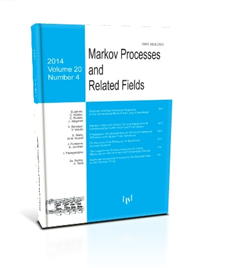On the Validity of the van der Waals Theory in Ising Systems with Long Range Interactions
P. Butta, I. Merola, E. Presutti
1997, v.3, Issue 1, 63-88
ABSTRACT
We consider an Ising system in $d \ge 2$ dimensions with ferromagnetic spin-spin interactions $-J_\g(x,y)\s(x)\s(y)$, $x$, $y \in Z^d$, where $J_\g(x,y)$ scales like a Kac potential. We prove that when the temperature is below the mean field critical value, for any $\g$ small enough (i.e. when the range of the interactionis long but finite), there are only two pure homogeneous phases, as stated by the van der Waals theory. After introducing block spin variables and relying on the Peierls estimates proved in [M. Cassandro and E. Presutti, Phase transitions in Ising systems with long but finite range, Markov Processes Relat. Fields, 1996, v.2, 241-262], the proof follows that in [G. Gallavotti and S. Miracle-Sole, Equilibrium states of the Ising model in the two-phase region, Phys. Rev. B, 1972, v.5, 2555-2559] on the translationally invariant states at low temperatures for nearest neighbor interactions, supplemented bya ``relative uniqueness criterion for Gibbs fields" which yields uniqueness in a restricted ensemble of measures, in a context where there is a phase transition. This criterion is derived by introducing special couplings as in [J. van den Berg and C. Maes, Disagreement percolation in the study of Markov fields, Ann. Prob., 1994, v.22, 749-763] which reduce the proof of relative uniqueness to the absence of percolation of ``bad events".
Keywords: Kac potentials,translationally invariant Gibbs states,couplings
COMMENTS
Please log in or register to leave a comment

